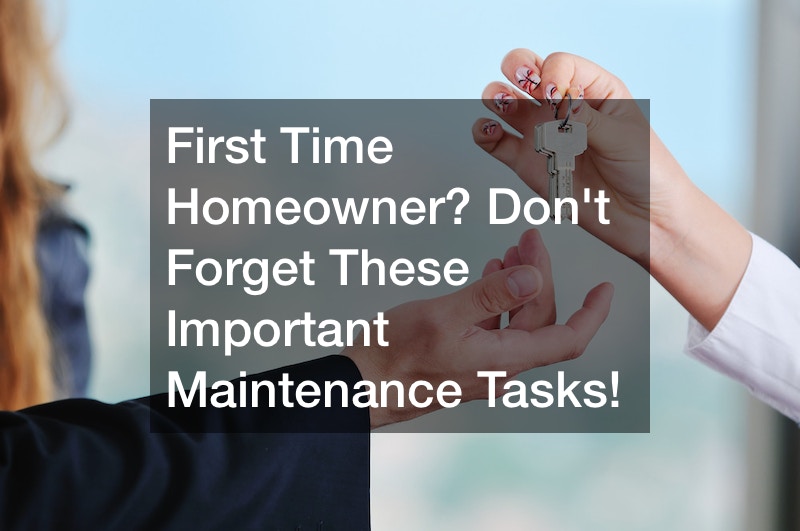
In 2022, US homeownership reached 65.8%, with 39% of the total being people under 35. Purchasing a home at a young age means you have worked hard towards a steady and higher income and building creditworthiness. At some point, you may be trying hard to keep up with the mortgage payments as a first time homeowner. But that shouldn’t deter you from performing maintenance tasks for your home. Below, we have discussed sixteen maintenance tasks a first time homeowner will likely need to remember. Unfortunately, failure to pay attention to them can decrease your home value.
1. Adequate Chimney Cleaning
As a first time homeowner, note that a chimney is an essential part of a home. It increases efficiency and prevents fire, corrosion, and smoke build-up in the house. WHO report revealed that around 2.4 billion people worldwide cook using inefficient stoves that use kerosene, coal, and biomass that pollutes the air. For this reason, you must sweep and clean your chimney to prevent the build-up of carbon monoxide. WHO reports revealed household pollution caused 3.2 million deaths in 2020. In the report, children were the most affected. Failure to clean the chimney is associated with non-communicable diseases like stroke, lung cancer, heart disease, and chronic obstructive pulmonary disease. The National Fire Protection Association recommends sweeping and cleaning the chimney at least once a year. It’s also advisable to have a professional inspect your chimney. A chimney cleaning service costs an average of $250.

2. Routine Pavement Maintenance
According to experts, pavements, including driveways and walkways, retain around 10% of a home’s value. However, they are prone to damage due to water intrusion during rainy seasons. Pavements also get damaged when they experience stress from heavy vehicles. This happens if you park trucks or farm tractors on your homestead. Additionally, contraction and expansion during seasonal temperature changes also affect the pavement. As such, schedule regular maintenance, like sealing the cracks, to prevent the spreading of cracks. Moreover, check on the pavement drainage to prevent rainwater from resting over the surface for extended periods. Roughly, a paving service like cleaning and filling potholes can cost you $3 to $15 per square foot, depending on your paving material.
3. Regular Cleaning and Inspecting of Fuel Tanks and Lines
We use various fuels for cooking and heating our homes. In fact, around 66.7 million homes use natural gas for cooking, water heating, and heating the home. Daily, an average US home uses 196 cubic feet of natural gas. With natural gas being essential fuel in our homes, it poses dangers. Natural gas leakages can cause fire or natural gas poisoning through inhalation. So, how do you prevent the dangers? By regularly inspecting and cleaning the fuel tanks and lines. Ideally, Schedule your propane tank and line inspection during summer when the heating needs are minimal.
4. Regularly Check On Your Roof
A good roof is not only beneficial for the home value but also for your safety. As a first time homeowner, you may forget about the roof because replacement happens after years. Forbes reports on replacement duration for various roofing materials.Slate and clay tile roofs last around 50 years, while concrete roofs can protect your house for even longer. Asphalt shingle roofs have a shorter duration than concrete and clays, 25 to 30 years. However, a metal roof is believed to last for 50 to 70 years.
A scarce kind of roof is the wood shingle roof which can protect your home for 30 years. Depending on the weather, roofing materials sometimes wear out in 15 to 20 years. But considering this duration, you can forget to check on your roof as a first time homeowner. Experts recommend inspecting the roof twice a year. That is during spring and fall when you are required to clean gutters and unclog the blocked drain pipes. A professional must do your roofing services to identify leaks.
5. Maintain the Floor
A well-maintained floor increases home value. But the most beneficial part of having good flooring is protection from diseases, infections, and accidents. Holes and cracks on tiles can be hiding places for pests. They can also store water, which later smells terrible in the house. On the other hand, bumpy tiles can cause accidents around a home. Mop the floor regularly and call for flooring services whenever you notice cracks or tile damage.

6. Inspect the Home Siding
Home siding material is essential in protecting a home. It prevents dusty wind from staining the walls and also offers decoration. You can opt for the siding replacement if worn out or dirty. In a survey, 53% of American homeowners changed their home siding in 2022. 39% of the homeowners said they replaced the siding due to damage, while 36% said it was for aesthetics. 32% of the homeowners said they replaced the siding for energy efficiency, while the other 32% said it was for home maintenance. As a first time homeowner, plan to change vinyl siding every 10 to 20 years. On the other hand, replace your fiber cement siding after 50 years and aluminum siding after 20 to 40 years.
7. Inspect and Repair the Fencing
Many homes in the US have no fences due to HOA restrictions and historical reasons. But home fencing can protect you from intruders and trespassers, improve privacy, create boundaries, and break the strong winds. Moreover, several homeowners claim fences offer aesthetic benefits. Regular maintenance and fence repair are essential to retain your home value. It’s advisable to inspect and maintain a fence annually. The professional maintenance costs vary depending on location and materials, but DIY fence maintenance can save you money.
8. Regularly Check On the HVAC
Nearly 90% of US households used HVACs in 2020 during the lockdowns. Two-thirds of the households in the states use central AC or central heat pumps. This clearly shows HVACs are essential devices in a home. Experts recommend inspecting the HVAC at least once a year. Usually, check the HVAC before winter and perform maintenance during summer when it’s rarely used. HVAC services require professionals at all times of inspection due to their complicated components.
9. Plumbing System is the Most Vulnerable
The plumbing system consists of the wastewater and the freshwater subsystems. The Environmental Protection Agency (EPA) found that an average US family wastes around 180 gallons of water weekly. This totals 9400 gallons of water yearly. Most of the water wastages are a result of faulty plumbing lines. So, seeking professional plumbing services once a year can save you from increased water bills as a first time homeowner paying mortgage loans. Moreover, checking the water heaters and faucets can save you energy bills.
10. Check on the Electrical Lines and Kitchen Appliances
Kitchen appliances like the refrigerator face a lot of moisture. Especially under the fridge, you must regularly check and clean it. Also, maintain other appliances like the microwave and blenders for energy efficiency. Although home wiring can last up to 50 years, according to experts, electricians must inspect the outlets and wiring at least once a year. This will save you from energy wastage and the potential risks of electric shocks.

11. Clean the Windows
Cleaning the home windows comes with several benefits. Dust and grime build-up on the windows can increase maintenance and repair costs due to damages when sliding. Secondly, cleaning the windows creates first impressions. In fact, most of the guests’ attention will go to a home exterior, including the siding, windows, and yard, the first time they enter a homestead. Moreover, clean windows let in more light, therefore, saving energy. Finally, it protects the indoor air quality, saving people from respiratory diseases.
12. Lube Garage Door Springs and Check Its Balance
In 2015, a report on the American Housing Survey showed that 80% of homes in the US have a carport or a garage. In another report, it was revealed that more than half of Canadian homes have attached garages. Apart from parking cars, most homeowners use garages as stores and workshops. As that’s the case, it’s easier to forget about maintaining your garage as a first time homeowner. The most vulnerable part of the garage is the door and door springs. Lubricate the springs and check the door balance to prevent falling off. If your garage door uses rollers, inspect and replace them.
13. Bathroom Cleaning and Repair
A bathroom is where we spend a few minutes after getting out of bed and in the evening after work. It’s also the mistiest place in the house, seconded by the kitchen. As such, your bathroom should be neat at all times. Why? A moist environment encourages mold and mildew. So, you risk getting infected with most respiratory diseases. A slippery bathroom also poses the danger of falling. On the other hand, corroded bathroom plumbing lines and showers can expose you to skin infections.
Surprisingly, a survey of US citizens revealed that despite bathrooms being regarded as a private sanctuary, most people had neglected them. 40% of Americans clean their bathrooms once a month. Another surprise was with the findings about shower curtains. Most Americans said they clean their shower curtains once in six months. Moreover, another survey nearly shocked the researchers. Most people reuse disposable razors and never clean their towels. Only 38% of people wash their bathroom once a week as recommended. Regularly clean your bathroom and inspect for any damaged plumbing lines, toilets, showers, and, most important, electrical lines.
14. Inspect and Dust the Fans
Fans cool the home during winter when temperatures rise. They also help to keep humidity in check to reduce mold and mildew growth. However, the location of the fans makes them the most overlooked devices. Although 87% of homes use fans, according to Energy Information Administration, most homeowners neglect cleaning them to the point of becoming inefficient. Another danger of neglected fans is dust build-up, which pollutes the room. This can result in respiratory complications for children, the elderly, and dust-allergic people. Beth McGhee, the author of Get Your House Clean Now, recommends cleaning ceiling fans once a month. She argues these are the simple tasks one can master, especially if you live in a dusty area or keeps your windows open.
15. Swap Out Fire Alarm Batteries
The fire alarm is an essential system that protects the property and the occupants from fire dangers. The fire alarm detects smoke and alerts the occupants or notifies the fire department. The National Fire Protection Association (NFPA)suggests that fire alarms should be inspected at least once a year. However, test the smoke alarm every month by pressing the test button. If you hear a chirping sound, know the system needs a battery swap. After ten years, replace the system since most of its sensors last for a decade.
16. Yard Cleaning
A yard is a crucial home area where you plant trees and grass. But the leaves can fall off and mess up the place. Also, if the grass overgrows, it can be a breeding area for pests. Take time to trim the grass and clear the leaves from the yard. Moreover, inspect the trees for infection and control diseases to prevent spreading. Other maintenance activities you can perform to improve the yard are planting flowers and more trees. Luckily, some activities, like lawn mowing, pest and weed control, and shrub pruning, are easy to DIY. You may only need a professional if you have a busy schedule or the task is complicated. Typically, seek arborist services when dealing with complex issues on trees.
As a first time homeowner, you must note that owning a home comes with responsibilities. You have to perform some weekly, monthly, and yearly maintenance tasks. Nevertheless, owning a home comes with great freedom and privacy. You also save on rent and other bills.




